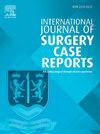Carcinoma in a male accessory breast; Case report with literature review
IF 0.6
Q4 SURGERY
引用次数: 0
Abstract
Introduction and importance
Accessory breast is a rare condition where regression of the mammary ridge fails. This ectopic breast can function as the same pectoral breast and respond to hormonal effects. Furthermore, in rare cases, it can develop into malignancy. A malignant accessory breast is very rare, especially in male patients. Although it had first been reported in a male in 1957, there were only a few reported cases following that with no sufficient epidemiological data.
Case presentation
A 60-year-old male with right axilla swelling is thought to be a benign lesion for excision. However, histopathology study of the specimen showed malignant cells, and a diagnosis of metastasis has been made and referred to our hospital. We did a full staging workup and eventually diagnosed him with primary accessory breast carcinoma, cT1N0M0.
Clinical discussion
Diagnosis of male accessory breast cancer is challenging. Patients usually present with painless swelling. As it is very rare, the possibility of metastasis needs to be ruled out before the diagnosis is made. No current diagnostic and treatment guidelines for accessory breast cancer, and in current practice physicians follow the guidelines of regular breast cancer. Another difficulty with this disease is the estimation of its prognosis.
Conclusion
Although accessory breast cancer is rare, it can be seen even in males. In patients with a lesion alongside the milk line, accessory breast cancer should be on the differentials list. Further studies regarding epidemiology, diagnostics, treatment plan, and prognosis of the disease need to be carried out.
求助全文
约1分钟内获得全文
求助全文
来源期刊
CiteScore
1.10
自引率
0.00%
发文量
1116
审稿时长
46 days

 求助内容:
求助内容: 应助结果提醒方式:
应助结果提醒方式:


